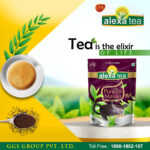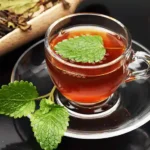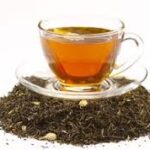How Is Tea Manufactured – The most popular beverage worldwide is tea. In the end, this forms the foundation of the economies of various nations, including China, Kenya, Sri Lanka, and India. The world loves Indian tea, especially Darjeeling tea, which is famous for its flavor and taste. Orthodox tea, one of the many varieties of tea, is quite popular because of its great quality. But, How is Tea Manufactured in India?
India enjoys their tea. With a cup of tea in your hands, a warm spot can be available everywhere, from a roadside shack to a high-end mall. The manufacture of tea and the Indian tea business are primarily chasing the rising demand for tea due to its aroma and quality.
Tea Manufacturing Process in India
There are three different categories of Indian tea manufacturing process. Assam tea (maximum cultivation), Darjeeling tea (tea of the finest quality), and Nilgiri tea (subtle and gentle flavors). Tea companies are actively involved in developing beverages for the millennial population. Indian youth love their tea cold and flavored with unique ingredients.
Some of the best innovations have resulted from the obsession with green and black tea and its health advantages. Nowadays, people drink various flavored teas to combat winter chill and heat. However, learning about the tea-making process is as thrilling as consuming your favorite tea. There are two different manufacturing processes for tea.
What are the old and new techniques of tea manufacturing?
Traditionally, tea was assembled using strategies passed down through the years. Skilled laborers meticulously hand-harvested tea leaves in nations like China and Japan. Only the most youthful and most fragile leaves from the tea scrubs were chosen in this painstaking procedure. Only the highest quality leaves were selected for processing thanks to the sharp touch of human hands.
In some places, such as India and Sri Lanka, tea leaves were accumulated by a process called “plucking,” in which laborers cut the leaves from the plants using sharp blades. Because only the top leaves, which include the highest concentration of taste components, were chosen for harvesting, this methodology required accuracy and close attention to detail.
1 Orthodox Tea manufacturing process in India
The Orthodox Tea Manufacturing technique, as the name suggests, is the conventional method of producing tea in India. It involves many steps that we are going to talk about.
- Plucking: To get the leaves ready for further processing, they are spread out to gradually lose moisture and wither for a few hours.
- Withering: After that, the leaves are very lightly fluffy, and round, and appear to make sure they are all exposed to the air equally. These tea leaves are full of moisture when they’re taken from industries, which is taken care of. 60% to 70% of the water is reduced from those leaves on a wire mesh, which helps a lot in the process. They are dried using air that is passed over them, which takes a lot of time, mostly.
- Rolling: The withering leaves are gently twisted by motorized jackets to give them their distinctive appearance of lengthy leaves. These rolling machines weren’t there in the past, so it was done by hand, but now they are used. After the twisting is done, the leaves look thin and wiry, which is commonly seen. This is an important step as it helps with fermentation later, as it’s a process of tea manufacturing.
- Fermentation: The leaves are rolled, then spread out to rest for a while so that fermentation can occur. Here, the leaf’s now-exposed enzymes mix with the oxygen in the air to change its chemical composition and give it a reddish-brown color. As it has the biggest effect on the complexity of the flavor and scent, this phase is crucial.
- Firing: This completes the manufacturing process. The tea is “fired” or dried to quickly reduce the moisture content of the leaves to under 3% and end the oxidation process. Then the tea is graded. This method helps a lot as less moisture is needed in the tea leaves for the process to work well. Driers are used to dry them out nicely, which takes 20-25% minutes to complete.
2 CTC Tea manufacturing process in India
Withering: The process removes moisture and promotes the development of flavoring chemicals by withering tea leaves. Workers spread fresh leaves out in a system of troughs, where thoroughly conditioned and monitored air passes through them.
CTC Or Crush, Tear, And Curl Process: The CTC, or crush, tear, and curl, the method entails constricting the dried leaves into a tight shape. The precisely ground grooves on stainless steel mandrels shape the tea and give it its granular quality. The process causes the leaves to release sap and essential oils, which further enhance the flavor.
Fermentation: In this context, the use of air regulates the enzymatic browning of the filtered leaves.
Drying: The moisture from the fermented leaf is quickly removed to give the tea its natural black look and enhance its keeping quality. This procedure reduces the moisture level of the tea, enhancing flavor and ensuring a longer shelf life.
Here are the 7 Tea Making Process steps
In this section of our blog, we mention seven main tea-making steps but the extent to which each one is used differs depending on the type of tea manufacturing.
| Plucking the tea leaves | It is the first step that every single type of tea must start with. For the tea manufacturing process, you must first remove the leaves from the plant. In some teas, tea leaves are plucked at a younger age, while others require a mature leaf. The most common pluck is 2 leaves and a bud called the “Pekoe” pluck. |
| Letting the tea leaves wither | Tea leaves will naturally wither once plucked from the bush like other plants and flowers. This process aims to let the moisture in the leaves evaporate. This process is done by drying the leaves under the sun in a room with good ventilation. This will help the leaves to soften so they won’t break if you roll them. |
| Rolling. Tossing and crushing the tea leaves | Manufacturing teas or processing tea leaves requires breaking down some cell walls so that tea leaves can react with air. Tossing, shaking, crushing, and rolling the tea leaves prepare them for oxidation. |
| Oxidizing the tea leaves | It is the most important part of manufacturing tea because oxidation determines its creation. If the cell walls of the leaves rupture, the air exposes them, and oxygen reacts with enzymes in the tea leaves. It will change the chemical composition of the tea leaves and the leaves will become darker. |
| Fixing the tea leaves by heating | It is the key step in processing tea leaves, heating them once the desired level of oxidation is achieved. Because it stops the enzymes in the tea leaves from any more oxidation. We can say that enzymes have done their job then heat is used to immobilize them. |
| Drying the tea leaves | After all these processes tea leaves slowly lose their moisture content and the goal of the drying stage is to bring that mixture down to 3-7%. Too much moisture causes tea leaves to expire faster. If teas are packed with less moisture then it will taste dry or burnt. The process of drying tea leaves provides a long shelf life and a delicious taste to tea leaves. |
| Sorting the tea leaves | It is the final step of manufacturing tea. Sorting the tea leaves before they are packed is a careful process of sifting through all the dried tea to remove any impurities, and stems. |
The tea industry in India today
According to www.ibef.org, India is one of the top 5 exporters of tea in the world, accounting for 10% of all exports. India exported tea for a total of approximately US$ 687.9 million in 2021. Between April and November of 2021, the fiscal year 2021–2022 period, India exported tea worth US$458,88 million. Over the years, India’s export price per kilogram has steadily increased. The cost per unit of tea in 2021–2022 was US$3.62 per kg. This cost US$3.52 the year before. In 2021–2022, the cost of tea exported from India increased by 17% from 2018–19. This has made it possible for the nation to profit more from its exported goods.
Alexa tea
Alexa Tea offers a variety of tea items that are all sun-dried to preserve their natural goodness to carry the Indian tea culture into the modern era. We have been selling specialty teas of the highest caliber that are all-natural and pure, derived from the best tea plantations in Darjeeling, the Nilgiris, Arunachal, and Assam. Consequently, our brand has a reputation for ethereal quality and delectable flavor.
| Name |
|
| Address: |
|
| Phone Number |
|
| Alexa Tea Flavours |
|
| Alexa Tea Network |
|
Why choose Alexa tea?
- We make Alexa tea from authentic raw material, ensuring it is of the finest quality. Alexa tea provides you with fresh flavors.
- It is products from the finest tea gardens of india like Deors, Assam, and other areas.
- Alexa tea comes in many different authentic flavors and has the best aromatic fresh odor.
- Tea is present in different parts of india and has been a regular cup of tea for every household.
- Experienced tea makers use the best manufacturing practices to produce the highest quality tea
Frequently Asked Questions About the Indian Tea Manufacturing Process
Q1: What kinds of tea are there?
Generally speaking, there are four basic types of tea: White, Oolong, Green, and Black. All of them are using Camellia sinensis for producing tea. Each type of tea requires a different manufacturing procedure and level of fermentation and oxidation.
Q2: Is tea beneficial to health?
Since the beginning of time, tea has been a popular beverage and the safest libation. Due to its alluring aroma, outstanding flavor, health-improving properties, and pharmacological potential, tea is the most consumed beverage in the world.
The most amazing source of antioxidants is tea, which also contains the polyphenols catechins, theaflavins, tannins, and flavonoids, including epigallocatechin gallate (EGCG), which is popular to have anti-inflammatory, analgesic, and anti-cancer properties. Tea is a diuretic that causes the body to feel both warm and chilly. You can clear your sinuses by inhaling the steam from hot tea, which hydrates your lips, throat, and nose.
Q3: Does tea have caffeine in it?
Yes, it does contain some caffeine. The amount of caffeine in a drink depends on a number of factors, including the plant, the type of tea, the picking season, and the length of the infusion.
Q4: – What are the top places in india that produce the best quality tea?
A – Different parts of India, including Himachal Pradesh, Assam, Darjeeling, Ooty, West Bengal, Kerala, and other places, produce the best quality tea
Q5: – What is the life of tea leaves and for how long it remains fresh?
A -Tea retains its freshness for around 7 to 8 months if stored properly inside an air-tight container. It loses its freshness if not stored properly
Q6: – What are the best ways to store the tea for a long time?
A – To store the tea best, put it in a tight container with no contact with the air. One can also put it inside the fridge so that it does not lose its essence in summer especially.
Q7: – What are the different types of iced tea we can make from tea?
A – We can make the iced tea flavored with lemon, peach, and watermelon in summer. This is the best use of tea in summer and is very effective.
Q8: – What are the benefits of having a cup of tea regularly?
A – Having tea regularly will improve your digestion and help your body recover from fatigue. It is refreshing to have tea in the summer and it provides us with antioxidants that help to fight against the free radicals





